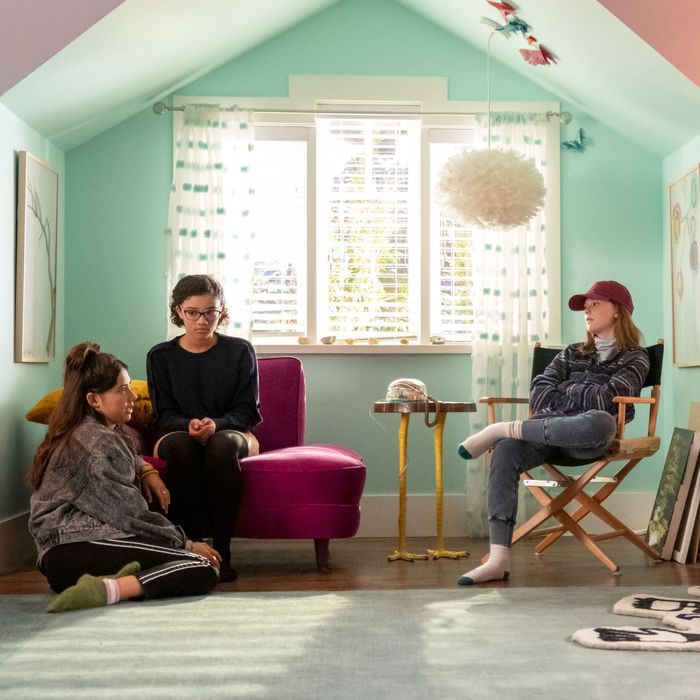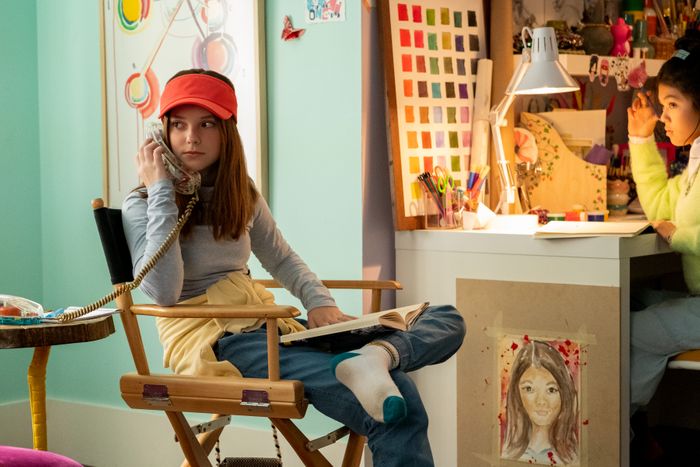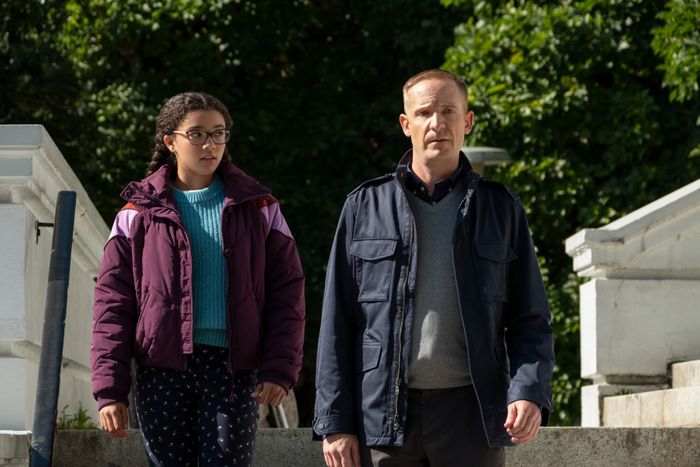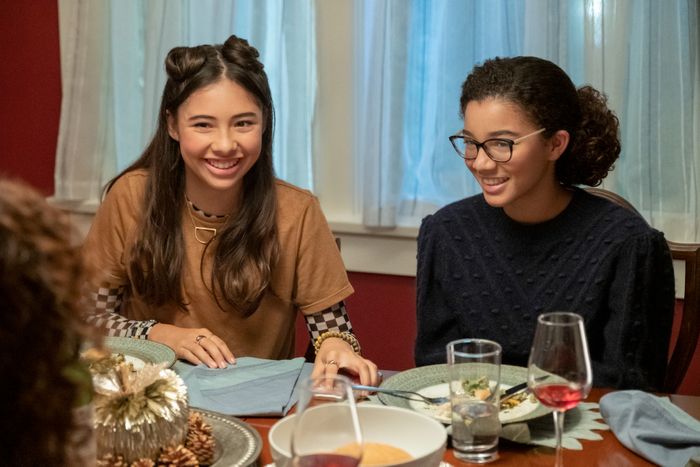
Photo: Kailey Schwerman/Netflix
Lucia Aniello has seen a lot of potential reboots cross her desk. She almost always passes. But three years ago, when her agent asked if there was anything from her childhood that she’d want to work with, she had an instant answer.
“There is only one thing,” Aniello responded. “And it’s The Baby-Sitters Club.”
If you know the canon of author Ann M. Martin and her team of ghostwriters, it is easy to imagine what Aniello’s childhood bookcase must have looked like: row after row of those Care Bear–colored covers, starting with Kristy’s Great Idea and expanding out into a franchise that has published over 200 installments, including spin-offs and Super Specials. In the books, narrated by alternating Baby-Sitters Club members, a group of best friends gathered each Monday, Wednesday, and Friday in Claudia Kishi’s candy-stocked room — because, of course, she was the only one with her own phone — to field calls from neighbors looking for basically qualified, competitively priced child care.
In between those meetings, which for a young reader in the ’90s were their own kind of fantasy (a 12-year-old could be the boss, middle schoolers could earn real money, and did I mention Claudia her own phone?!), the girls dealt with the slings and arrows of adolescence, from first crushes and failing grades to divorce, disease, and death. For a YA market that would become almost parodically high-concept in the decades that followed, what made The Baby-Sitters Club endure was the grounded, vivid, and accessibly escapist world it invited readers to enter. Aniello believed that the emotional pull of those books was as strong as ever, not just for nostalgic adults but for a new generation of fans.
In August 2017, she met with producers Mike DeLuca and Lucy Kitada — who, in conjunction with Walden Media, had acquired the rights to The Baby-Sitters Club a year earlier — and pitched her vision for the show: a dramedy that kids could watch with their parents, one that celebrated these girls’ ingenuity and ambition, and took their inner lives, hopes, and insecurities as seriously as they did; a modern show with just enough nostalgia to give longtime fans that warm, fuzzy feeling when they watched. They loved it, then started the search for a writer with whom Aniello could partner. That fall, Kitada suggested Rachel Shukert, a GLOW writer (and former Vulture recapper) whom Aniello already knew and had worked with.
Soon after, Shukert got an email from Kitada asking if she’d read BSC growing up. With a newborn baby at home, she was “only half-conscious” at work. “I could barely remember my own name, I was so tired,” she said. “But I remembered every detail of The Baby-Sitters Club.” Their handwriting, their outfits, the names of all the kids they babysat for, “the exact wording of sentences.” It all came back. “My entire childhood was The Baby-Sitters Club,” she said. “This is my lizard brain.”
Shukert signed on as showrunner, to Aniello’s delight, and the team was locked in by December. Netflix wouldn’t enter the picture for another year and a half, but The Baby-Sitters Club felt like a surefire idea. “Rachel and I immediately seemed to have the exact same point of view on it,” Aniello said. “It was a really special thing to go, Oh my God, this is exactly who should be in charge of this show.”
Aniello and Shukert quickly agreed that the series shouldn’t go in the Stranger Things direction, set in a Technicolor-tinged past. “The books weren’t written as period pieces,” Shukert said. “They were written to be immediate.”
But pulling The Baby-Sitters Club into the present day meant solving an important technical problem: What do you do about the landline phone? “The logistics of it were the first piece that had to be solved,” Shukert said. “How would this club work now?”
So they came up with this elegant logic: Claudia has her own phone line because her brainiac sister, Janine, needed high-speed internet, and the line came with the package. (Ever wonder why Comcast insists on bundling a landline with marginally less expensive internet? Turns out they were laying the groundwork for this Baby-Sitters Club reboot.) Though Kristy is skeptical that this enormous plastic contraption, which is roughly ten times the size of an iPhone, will actually work, Claudia shrugs. “The Etsy shop I bought it from said it’s fully operational.”
Kristy (Sophie Grace), in her directors chair, taking a call on the BSC hotline.
Photo: Kailey Schwerman/Netflix
Sure, the girls do also have cell phones, but they don’t exactly have unrestricted use of them. (Mary Anne’s strict dad condemns her to a flip phone … the cruelty!) They’re on social media, but age restrictions cap their activity online — and “they’re not addicted to it,” Shukert adds — so the club would need an easy way for would-be clients to hire a sitter. Claudia’s retro phone suddenly made a lot of sense, even for the zoomer generation.
After clearing that logistical hurdle, Shukert and Aniello were confident that the emotional core of The Baby-Sitters Club wouldn’t feel dated. If anything, they realized as they reread the books in the year and a half before opening a writers’ room in 2019, the moral core was as pertinent as ever. “The values the girls impart to me and Lucia are just so relevant in the present day,” Shukert said. “It’s so much about being a good citizen, standing up for people, being a part of your community in a way that’s positive. It felt like a good antidote to a lot of things.”
Readers will recognize quite a few story lines in the series, which roughly track with the first ten BSC installments that cover the girls’ seventh-grade year. (For the next 200-plus books, they live in a time loop where they never graduate from middle school.) The most memorable incidents in this stretch appear in the show with surprisingly minimal modifications: Kristy’s single mom gets married; Claudia’s beloved aunt Mimi has a stroke; new girls Stacey and Dawn move to the fictional Stoneybrook and acclimate to their new environment. There’s nothing all that ’90s about the big-ticket dilemmas.
“I don’t think that much about being a 12 or 13 year old girl has really changed since we were that age,” Shukert said. “You still have a lot of the same stuff going on. You still love and need your friends. You’re still trying to figure out who you are and what you want to wear and who you like.”
There’s also plenty of ripped-from-the-page Easter eggs for book fans to spot. “Kristy’s collie Louie is really a collie! Kristy really sits in a director’s chair! The jaguar is the mascot of Stoneybrook Middle School!” Shukert said. “We really want adults who loved Ann’s books to be transported back to their childhoods and be seen, and we wanted to introduce these books to a new generation.”
But as Shukert realized as she revisited the books, a crucial element wasn’t top of mind for her as a young reader. “None of their lives are perfect,” she said. “They have complicated families. They go through divorce. Stacey has a chronic illness. Claudia is struggling in school.”
It would be easy to write a character like Mary Anne Spier, the secretary with perfect penmanship and a boring boyfriend, as Kristy’s shy sidekick. But Mary Anne isn’t a wallflower just because. “I don’t think I realized as a little kid that Mary Anne is shy because her mother died and she doesn’t have a model for how to be a woman in the world, so she looks to other people for cues,” Shukert said. Same goes for Kristy, the president and founder of the BSC: “Kristy is so controlling because her father sort of abandoned her family. She wants to control everything she can because if she is in charge, she doesn’t have to think about how deeply that hurt her.”
“Putting together the psychologies in a new way, it made sense of why these characters are so full and why they landed with people who read them,” she explained. “They’re really well-rounded characters.”
Equipped with a vision for Stoneybrook and nuanced portraits of the girls who would populate the town, they pitched to Netflix. In February 2019, the streaming giant ordered it straight to series, with ten half-hour episodes for the first season.
Next, Aniello and Shukert had to find their five leads: Kristy, Claudia, Mary Anne, Stacey, and Dawn. Auditions took place in May 2019; casting was finalized by the end of the month. Over 2,650 actresses submitted for the five leads and they auditioned more than 1,000 of them. “We saw every teen over 10 and under 16 in North America. We saw some girls in Australia, some girls in Dubai,” Aniello said.
The girls needed to not just work as individuals but have believable chemistry — “Finding that alchemy was really important to us,” Aniello said — and also look the right age. “We were really trying to find that sweet spot where they didn’t look too old, but were plausibly old enough that you could leave your kids with them,” Shukert said. “We looked at 11-year-olds, but they were too young. They’re babies! Their voices haven’t dropped at all.”
“And we wanted to find girls that were naturally like the characters already,” Aniello added. “We all know which babysitter we are.” For the record: Aniello is Kristy with Stacey rising and Shukert is Claudia with a Kristy rising. (Personally, I am a Stacey-Dawn hybrid, but I was a Kristy as a child and I do still have some Kristy energy.)
The casting for Claudia called for “authentic Japanese-American actresses,” but the other parts did not specify ethnicity. Because the writing and casting processes overlapped — the writers’ room opened on April 29 — the writers began to think more expansively about their source material as girls of different backgrounds read for each part. Though some of the books centered Claudia’s Japanese-American family and Jessi Ramsey, a Black ballerina and junior sitter, the majority of the Baby-Sitters Club and the wider world of Stoneybrook were white. (And while readers have made educated guesses about the sexual orientations of some characters, in the books, everyone is presented as straight.)
After their reread, Aniello and Shukert were nevertheless struck by how much possibility was waiting for them in the pages. “I think that what was interesting in terms of diversifying the cast is there were scenes that felt like … as if it was suggested in the books,” Aniello said. “Ann did make books that were inclusive for the time, so to modernize it is an extension of the legacy.” (Martin wasn’t in the writers’ room, but she gave feedback on scripts, talked with Aniello about the show’s direction, and did a set visit with the cast and crew.)
Take Mary Anne Spier. Her mother has died and her widowed dad is extremely strict, dressing her in borderline-babyish clothes and forcing her to wear her hair in pigtail braids. In the new series, she’s a biracial character portrayed by Malia Baker. “It helped explain a little bit why someone like Richard” — her dad, played by The Good Place’s Marc Evan Jackson — “would be the overprotective parent that he is, if he’s the white father of a daughter he wants to protect,” Aniello said.
Mary-Anne (Malia Baker) and her dad Richard (Marc Evan Jackson).
Photo: Kailey Schwerman/Netflix
It takes the efforts of not just her old friends but the arrival of Dawn to get restrictions lifted at the Spier household. When Mary Anne’s uptight dad starts dating Dawn’s free-spirited mom, he relaxes enough to give Mary Anne room to grow. Cynthia Ann Summers, the series’s costume designer, decided to reflect that growth through Mary Anne’s evolving hairstyles across the season. Once she convinces her dad to loosen his grip on her self-expression, she blossoms.
“The biggest part of the story, for her and her dad letting her be herself, is her taking her hair out of her braids, wearing it down and up in different ways,” Summers said. “It was a really wonderful opportunity for her to express herself.”
Then there’s Dawn Schafer, who in the books resembles a Sweet Valley High twin: beachy blonde hair, blue eyes. In the Netflix series, Dawn is played by Xochitl Gomez, a Latinx actress. “Dawn is a California girl coming back to the East Coast,” Aniello said. “She was already into the environment, she already had stuff that felt like, if she was existing today, she’d be an activist in her friend group. So some of these things were already halfway there, and when you overlay the feel of, What is that in 2020?, it revealed itself.”
Dawn (Xochitl Gomez) and Mary-Anne (Malia Baker).
Photo: KAILEY SCHWERMAN/NETFLIX
Still, Shukert noted, there was plenty of room to imagine a bigger world for Stoneybrook beyond the main cast. Just look at Dawn’s family: After she comes to Stoneybrook with her mom, her dad is now living with another man — a fact that is explicitly stated, not just alluded to. “Even the families they take care of, there was this blanket assumption in the ’80s that these families all had white heterosexual parents,” Shukert said. “But it doesn’t have to be that way!”
For a show that winks at the ’90s, but is emphatically not trapped in time, The Baby-Sitters Club did allow itself one sly casting choice: Alicia Silverstone as Kristy’s mom, Elizabeth. “We all know her as being this huge star, and she is!” Aniello says of Silverstone. “What if somebody like that plays a single mom with four kids just trying to make it work? It helped to have somebody like that just be an everyday mom who is just as charming and winning and likable. For us, it was a cool notion of subverting who you think would be playing it.”
“We wanted the parents to feel special in their own way,” Shukert said. “I felt strongly, as a mother, I wanted the moms to be interesting people, and not just generic moms that you see in a commercial. These girls are so amazing, the people that raised them have to be interesting.”
Stoneybrook is “a bit idealized,” Shukert admitted, meaning that it’s still the small town where everybody knows everybody but nobody judges anybody, where you can be your best self and feel supported, safe, and valued. This also makes it something of an escapist wonderland for those of us living in nonfictional America today. Kristy and her crew don’t, say, follow the president on Twitter. Breaking news alerts don’t interrupt BSC meetings. And, as Shukert pointed out, “There’s no COVID in Stoneybrook.” (Shooting on the season began last August and wrapped in mid-October.)
A show like that can run the risk of seeming too out of step with the moment, so obviously an artifact from the Before Times that it feels far older than it actually is. But Shukert feels like she’s sending out this sunbeam of a series into what can feel like all-consuming darkness.
“The world is so polarized and divisive and angry, but you’re still putting dinner on the table and raising your kids,” she said. “For me, it’s like, what do I want to put forward in the world? What are the values I want to impart? How can we get back to this without hammering it in a dogmatic or rhetorical way? How are you modeling what you want to see in the world? How are you being a good citizen, a good caretaker, a good friend? How are you putting forward the values of honesty, love, loyalty, and tolerance?”
Or, as Aniello put it, “If you’ve already watched every episode of Great British Bake Off and you need something else to feel good, watch this.”


